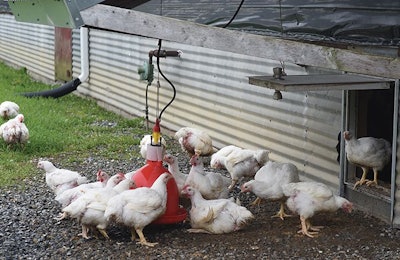
With a continued focus on continuous improvement of animal welfare, Perdue Foods is expanding its number of farms with free-range outdoor access, testing the feasibility and benefits of on farm-hatching and testing other welfare-focused measures.
Four years ago, Perdue Foods launched an animal welfare initiative aimed at establishing a culture of continuous animal welfare improvement in the company. At its annual Commitment to Animal Care Summit, held on October 22, 2020, leaders of the company spoke about the progress made thus far and new initiatives for 2020.
Perdue – the fourth-largest integrated poultry producer in the U.S. – uses a four-part plan based on:
- Chickens: Providing for what chickens want rather than just need.
- Farms: Commitment to the farmers who raise the animals.
- Trust: Building public confidence through transparency on welfare programs, goals and progress toward meeting them.
- Continuous improvement: On-going commitment to continuous improvement in animal welfare.
At the event, Dr. Bruce Stewart-Brown, the company's senior vice president of food safety, quality and live operations, reviewed the 2020 initiatives and how the company fared.
1. Ending skip-a-day feeding for breeders
Typically, Perdue begins skip a day feeding with breeders after four weeks of age to maintain a productive weight. In this setup, there's more anxiety for the bird. The company saw an opportunity to attempt feeding every day.
It set up a trial around every day versus skip and evaluated flock uniformity at 20 weeks as well as bird stress. It found good uniformity in the everyday feeding group but was inconclusive on whether it reduced stress. He said Perdue will keep working on everyday feeding.
2. Testing on-farm hatching
Perdue wanted to understand the benefits of getting a chick food and water as soon as possible, so it tested hatching birds directly on the farm.
The concept was to take an egg ready to hatch, at 18 days, from the incubator, place it in a specially designed hatcher and let it hatch onto litter with access to a drinker and a feed pan. This was tested at a Perdue research farm and Stewart-Brown said he sees an opportunity for it in the future.
3. Assessing leg health
In concert with animal activist group Mercy For Animals, Perdue looked into broiler weight distribution and how it affects welfare. Broiler birds have heavy breasts, tilting them forward and stressing the legs. Perdue wanted to make a specific examination of leg health and how it corresponded with broiler weight.
It identified groups of farms that produced more than five flocks of birds that consistently produced birds with either exceptionally strong or exceptionally poor average gait scores. It will study those groups of standouts more to understand the correlation between good and bad performance on this metric.
4. Poultry handling and transportation certification
In 2020, Perdue achieved its goal of getting more than 80% of its live haul workforce trained and certified in poultry handling by a third-party organization. It's currently 83% trained and plans to finish certifications after COVID-19 restrictions are lifted.
5. Reduce culls
Culling is a key part of chicken growing and is needed to euthanize birds who cannot thrive. Perdue heard feedback from its growers saying there would be less culling with better chick quality. It took this and established a goal to reduce culls between two and four weeks of age by 15% from the year before.
Stewart-Brown said it was not meeting the goal when it started in July 2019 but by August 2020 it was starting to meet that goal. He's confident progress will continue there. Moreover, through its trial, the company gave growers the goal to limit culls to less than five a day. Consistent culling reduces mortality, he said.

In 2020, Perdue tried to reduce culls between two and four weeks of age by 15%. (Courtesy Perdue Foods)
6. Expanded outdoor access
In 2020, Perdue said it wanted 25% or more of its birds to have outdoor access or be free-range. Stewart-Brown said it required about 800 houses to be retrofitted. Perdue paid for adding so-called pop-hole doors and pastures that comply with the U.S. Department of Agriculture's organic standards giving birds equal access to outdoor and indoor space.
In every new free-range farm, Perdue added two new enrichments its farmers designed: the so-called carpenter bench and a chicken tree. Both wooden structures are taller than the birds and give them multiple places to perch, ascend and descend.
7. A grower contest for free-range pasture designs
Chickens can have access to the outside yet never go there. Birds must be incentivized to move out of the house. It asked experienced free-range farmers for ideas on how to get the birds outdoors. Those farmers shared how they are changing their indoor and outdoor design and management techniques to get the birds outside consistently. Perdue is integrating winning ideas from a design contest into its plans.
8. Controlled-atmosphere stunning
Perdue is committed to going 100% controlled-atmosphere stunning (CAS) because it is convinced the technology is right for the bird and its plant employees.
It installed a system in Milford, Delaware, and is committed to installing new systems in the future. It's researching which system is right for it currently and is on track to select a second system to install by the middle of 2021. He said CAS is slow and expensive, but Perdue is enthusiastic about it.
9. Animal care incentives
Perdue set up an incentive program with growers based on paw quality. This was based on an operation that was doing particularly poorly with paw quality with a grower showing little enthusiasm for managing for paw quality.
Perdue created an incentive program allowing growers to make $2,500 per barn per year if it achieved certain results. Because of this, paw scores improved. It's shown to work, and Perdue will expand welfare incentives.
10. Meeting the Better Chicken Commitment
Perdue didn't meet its goal of meeting standards set by the Better Chicken Commitment and auditing program. The commitment is a science-based chicken welfare policy that addresses issues related to breeding for fast-growth and high-yield, housing, stocking density, and slaughter. More than 170 leading food companies – including Subway, Burger King, Nestle and Compass Group – are publicly committed to meeting the standards of the Better Chicken Commitment.
The company is no less enthusiastic about the concept, but a program not authored by Perdue must be written so it can be audited for how it uses enrichment, space, breeds and CAS.
11. Continuous improvement
Perdue assesses itself on 10 metrics: chicken behavioral training for flock advisors, paw health, video monitoring, culture, windows, activity, improved farmer relationship, audit results, public engagement, space.
Stewart-Brown said the company saw improvement in almost all areas but pays special attention to improving the farmer relationship. It wants to see more improvement in measuring and improving the activity levels of the birds and needs the technology to move ahead. As for its goal of training flock advisors, COVID-19 reduced opportunities for training.

In 2021, Perdue will study the welfare implications of raising chickens that differ in age, growth rate, feather color and activity in the same flock. (Courtesy Perdue Foods)
Looking ahead to 2021
Stewart-Brown said the company will carry over seven initiatives from last year and introduce three new programs:
- A continued heavy bird study identifying the top 3 issues in birds raised to more than 7.5 pounds.
- Studying the welfare implications of raising chickens that differ in age, growth rate, feather color and activity together in the same flock.
- Continued research of on-farm hatching.
- Studying whether early chick feeding and watering is an animal care advantage.
- The second round of its free-range pasture design contest.
- Researching pre-shipment or early chick water supplement for nutritional and/or stress support.
- Free-range: Researching successful methods for getting birds to utilize pasture.
- Reducing two- to four-week culls by 15%.
- Initiate a young farmer development group.
- Expand animal care incentives to a second operation.

















